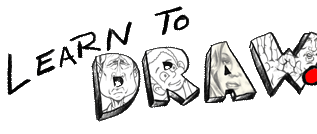First came line, then shape, then perspective,
proportion, and foreshortening. Now here's my favorite
part of drawing: Light and Shadow. Without light and
shadow even the most perfectly executed drawing with
perfect perspective and right-on proportion is going to
look flat. Light and shadow give a "real world" depth to
a drawing and really makes it look three dimensional.
The drawings that we create now will really POP out of
the paper with light and shadow present in the drawings.
We see shadows every day, but we really don't LOOK at
them. We don't look at the shadow to try and figure out
where the light is coming from, or how many light
sources there are, or what the quality of the light is.
How you draw your shadows will tell all of that to the
viewer, and if the shadow is drawn wrong, the viewer
will know that the drawing is "wrong" but they may not
understand why.
 |
|
Lee Harvey Oswald |
Here's a classic example of "wrong"
shadows: Look at this photo of John F. Kennedy's
assassin Lee Harvey Oswald. People say this photo has
not been doctored or retouched, but I think it has. Look
at the shadows in the photo. Look at the shadow under
his nose. This type of shadow occurs when the sun is
very high in the sky (around noon) and the sun is
shining straight down on the head. See that the shadow
is directly under the nose and that the shadow is not
off to the left or right of the nose. Yet, if this
picture was taken around noon, Oswald would cast almost
no shadow with his body because his body shadow would be
directly under him. But, as you can plainly see, he
does have a shadow. Granted, the shadow isn't very
long, but it seems too long to be the same shadow that
is being cast under his nose. Also, if we look at
highlights in this picture we see that the highlights
(or white areas) on his face are much better defined
than the highlights on his right arm. Basically, there
are no highlights on
his arm, it's all one pretty even tone. That may be the
hairs on his arm breaking up the smooth tone of the
skin, but I'm not sure. Further, his
face has the three types of tone that we look for in
drawing: Highlights (the whitest whites), mid tones (the
middle, grayer tones), and shadows (the darkest areas).
But his right arm only seems to have two tones: shadows
and mid tones, no highlights. Also his head looks a
little too big for the body - The proportions look a
little off to me. This means to me that the body was
photographed under different lighting conditions than
the head. All right, I'm not trying to say who did or
did not kill Kennedy, I just know that this photo has
wacky shadows that are "wrong" which you can see if you
look closely. When you draw, you should be very aware of
your lights and shadows and keep in mind where they're
coming from so you can keep them consistent throughout
your drawing. Each plane or surface or element of an
object might cast a shadow, and so you should keep the
shadows all being cast in the same direction if the
shadows are all coming from the same light source.
 |
|
Finding the light source |
For the most part, you can look to the shadows to see
where the light is coming from. If the shadow is on the
left of the object, the light is coming from the right.
If the object has a smooth surface you can see a
highlight reflected in the object. That's a dead give
away as to where the light is. Just look for the
highlight and that's where the light source is. The
shadow will be shorter the higher up the light source
is. The shadow will get longer the lower the light
source gets. |
